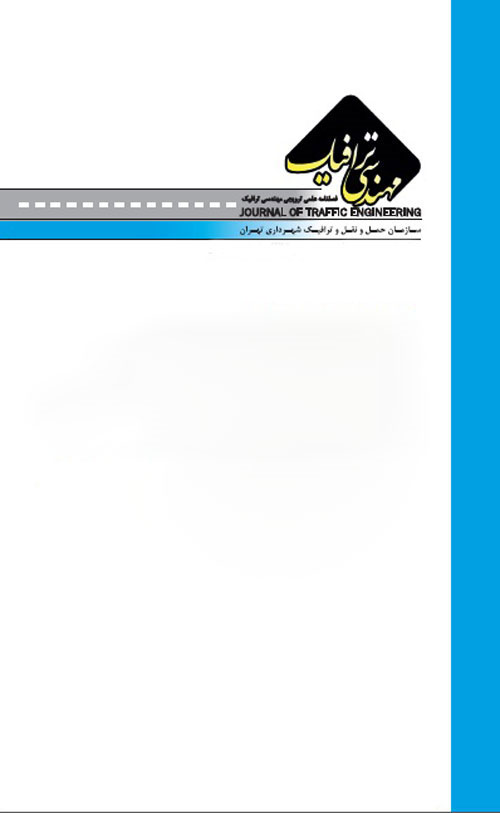فهرست مطالب

نشریه مهندسی ترافیک
پیاپی 62 (پاییز 1394)
- تاریخ انتشار: 1394/09/20
- تعداد عناوین: 7
-
-
Page 5Growth of population increasing travel demands and traffic congestion and so establishing of the efficient transportation system is necessary. Monorail is railbase transportation system with many advantages such as: lower costs, and higher construction speed in comparison with metro. Different countries have devoted their transportation budget for constructing Monorail. This paper researched about the advantages and disadvantages of Monorail in Iran by SWOT method and opportunities and risks are evaluated and presented by statistics.Keywords: Travel demand, Railway systems, Monorail, SWOT
-
Page 13Industrial estates have a special role in the economy of our country. They play a considerable function in creating a healthy and productive employment, reducing unemployment, more appropriate using of production resources, developing of technology and scientific researches and promoting of exports. Several parameters, such as social, economic and environmental have effect on locating of industrial estates. This study is based on analytic network process (ANP) and Geographic Information Systems (GIS) for selecting the optimum location for the establishment of industrial estates in the Babol city. The results show that public access with normal weight of 0.1804 is more important than other factors.Keywords: Industrial Estates, ANP, GIS, Public Access
-
Page 23The estimation of roadway capacity is essential in the planning, designing, and operation of roadway facilities. This paper is studied the influence of roadway geometric characteristics on capacity at tangents and horizontal curves as well as on capacity loss at the change from tangent to curve. Applied capacity estimation method is based on extrapolation from a fundamental diagram representing the relationship between traffic flow and density. The effects of different vehicle types are accommodated by converting them into equivalent passenger car units. Regression analysis is applied to investigate the relationships between geometric characteristics and capacity. The best regression models for each case (i.e. capacity at tangents and curves, and capacity loss between the two elements) are introduced in the paper. In the tangents, the significant independent variables are lane, shoulder width, and tangent length. In the case of curves, the significant variables are curve radius and lane width.Keywords: Roadway Geometry, Capacity, Horizontal Curve, Flow-Density Relationship, Regression Analysis.n
-
Page 30Lane changing in the weaving makes a type of turbulence in traffic flow and the consequently the speed and the capacity of the weaving section is decreased. Due to lack of the manual for urban principal arterials, calibration of these models is necessary for our country. One of these models that are used to evaluate the level of service of the weaving sections is lane-changing rates model which will be developed in this paper. Thus, data of the traffic flow and lane-changing rates have been collected in 9 principal arterials of Tehran. Then, two models for prediction of weaving and nonweaving lane-changing rates are developed. Validations also confirm the accuracy of the developed models. The investigation of weaving lane-changing rates reveal that lane-changing rates increase by increasing length, lane number, the ratio of weaving flow rate to total flow rate, and interchange and intersection density.Keywords: Weaving, Non-Weaving Lane-Changing Rates, Section, Urban Principal Arterials
-
Page 39Safety of vehicles in traffic is one of the most basic principles of traffic engineering and transportation planning in the world. Roadway design is one of the most significant factors that affect driving behavior and safety. In this study the effect of combination of three roadway design elements shoulders width, guardrail existence and roadway geometry (curvature) on the behavior of heavy vehicles drivers in the two lane roads was evaluated using bus driving simulation (BI 301 FULL). Six scenarios were designed to investigate the effects of these three elements. Forty heavy vehicles drivers participated in an experiment with a driving simulation in designed scenarios. In the case of existence of guardrails, the shoulder width have a specific effect on speed and distance to the midline. The beneficial effect of shoulder width on driver behavior greatly reduces in the absence of guardrails. The rate of changes in speed and distance from the midline with the changes in shoulder width is lower in the night than the daylight due to low speed and high workload in the night. Roadway geometry can be used to decrease speed. The results also revealed controlling the width of road shoulders and placing guardrails is a safe way to control speed and lane position.Keywords: Driving Behavior, Heavy Vehicles, Driving Simulation, Shoulder Width, Guardrail, Roadway Geometry
-
Page 46Driving violations have been one of the causes of problems, and traffic accidents in all of world. The purpose of this research is to investigate the relationship between driving anger, emotional self-regulation, and inhibition ability with risky driving behaviors. In this study, 117 drivers who were volunteers to enter taxi driving organization were selected. The subjects were completed Aggressive driving questionnaire, Gratz and Roemers emotional self-regulation questionnaire, Manchester driving behavior questionnaire and go/no go task. The first study showed that there is a positive relationship between driving anger and difficulties in emotional self-regulation with risky driving behavior (pKeywords: Aggressive Driving, Emotional Self Regulation, Inhibition, Risky Driving Behavior
-
Page 57Integrated management of transportation is defined due to purposes of city integrated management. But many ambiguities and overlapping in the some aspects of managements, plans and facilities make conflicts in the definition and determination of integrated management. This paper attempts to provide a suitable structural separation of administrative tasks and presents solutions to meet overlapping activities and then finding definition for unified management platform in Tehran. This study focuses on how to define the structure and organization of transportation and traffic management as well as the separation of administrative tasks in Tehran.Keywords: Integrated Management, Transportation, Separation of Administrative Duties, Parallel Activities

